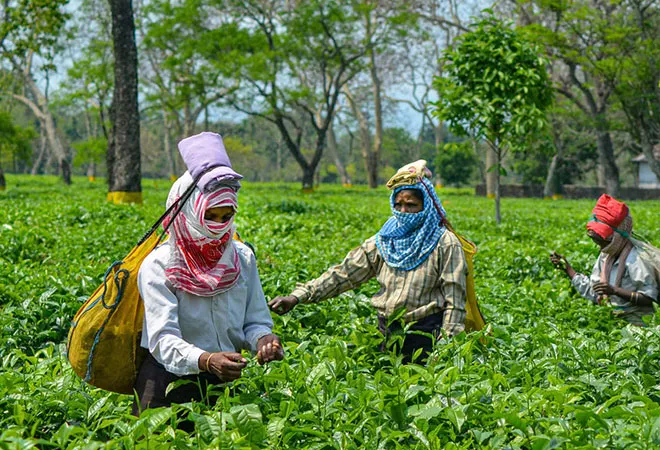-
CENTRES
Progammes & Centres
Location

As the country is recovering from the second wave, the most important question that lies ahead of states is on the economic front. The fear of a third wave with new variants being identified at regular intervals, is evident. However, with the economy taking a hit and inflation numbers going up, another lockdown seems almost implausible. Alternate routes to deal with the pandemic or to rather live with the pandemic has become more of a necessity than a norm. The second wave saw cases spiraling up across various states in the country and to restrict the spread, states were opting for a lockdown. However, the state of Assam, with a population of more than three crores, sharing national and international borders with seven states and two countries respectively, took a different route and preferred containing the spread of the pandemic through a balanced approach of track, test, and treat on the one hand and partial curfews on the other to keep the economy going.
As Assam saw a rise in COVID-19 cases during the start of April, the plan of action from the government’s end was very clear. The state could not afford to go into lockdown, and therefore, the government’s actions needed to strike a perfect balance between saving lives and livelihoods amidst the second wave. On the health infrastructure front, the state already had eight oxygen plants producing 5.25 metric tonnes of oxygen per day with five more plants in the pipeline by April. At a time when states across the country were reeling under the pressure to get oxygen supplies, Assam was one of the states that extended support to states like Manipur, Arunachal, Meghalaya, Mizoram, and Tripura by sending in surplus oxygen. Ramping up hospital beds by engaging agencies like DRDO, Indian Army, and PSUs, apart from the state’s own resources, in a short period of time was one of the reasons that Assam never witnessed shortage of beds or oxygen throughout the second wave. Further, the state also extended help and collaborated with other states in sending 2,000 Remdisivir injections to Jharkhand, and exchanging Covaxin for Covisheild vaccine with Meghalaya during the period.
Ramping up hospital beds by engaging agencies like DRDO, Indian Army, and PSUs, apart from the state’s own resources, in a short period of time was one of the reasons that Assam never witnessed shortage of beds or oxygen throughout the second wave. Further, the state also extended help and collaborated with other states in sending 2,000 Remdisivir injections to Jharkhand, and exchanging Covaxin for Covisheild vaccine with Meghalaya during the period
Secondly, the state opting for well-planned curfews and relaxation of restrictions in a phased manner, which were in proportion to the number of cases and the TPR (Total positivity rate) throughout the last three months have worked well for the state. The TPR in the state hardly went above 10 percent throughout the second wave and stands at 1 percent-2 percent as per the most recent data. This, however, has not made the state complacent. Testing, vaccinations, and ramping up health infrastructure for children who could be more susceptible to the virus if the country witnesses a third wave are in progress across the state. The state has also revamped its community surveillance plan “Nischsyata”, which aims to vaccinate 28,000 villages across 152 blocks, including villages that shares borders with neighbouring states and countries. Further, the government has also made institutional quarantine compulsory for COVID-19 positive people with comorbidities across age groups in districts that witnessed a sharp rise in cases. Proactive steps such as these were only possible due to the farsightedness of the government and ramped up health infrastructure (beds, ventilators, ICU’s) in the state that never allowed any patient to miss out on treatment due to lack of beds. The economy too is coming back to normalcy as the state is relaxing the COVID-19 curbs in a phased manner as a result of a sharp decline in the number of cases in the state.
Socio-economic development of the tea garden workers of Assam has always been one of the focus areas of successive governments in Assam. The community, which comprises of almost 17 percent of the state’s population, saw one of the sharpest rises in COVID-19 cases during the month of May. This time of the year, which is ideally the picking time for internationally famous second flush teas, led to about a million of tea workers going to the gardens to work for their wages amidst the second wave. During the second week of May, the surge in cases due to negligence in adhering to the COVID-19 norms coupled with an already high prevalence of diseases like malnutrition, tuberculosis, and hypertension amongst the community, was leading towards a situation that could well have gone out of control. However, the government intervened proactively with banning home isolation for the infected, establishing more COVID-19 centres across tea gardens, ramping up testing and vaccination by allowing walk-ins across tea gardens and community vaccination programmes. The timely intervention by the government prevented the tea gardens from becoming a hotspot for COVID-19 and as on date the tea gardens are witnessing far less cases.
During the second week of May, the surge in cases due to negligence in adhering to the COVID-19 norms coupled with an already high prevalence of diseases like malnutrition, tuberculosis, and hypertension amongst the community, was leading towards a situation that could well have gone out of control. However, the government intervened proactively with banning home isolation for the infected, establishing more COVID-19 centres across tea gardens, ramping up testing and vaccination by allowing walk-ins across tea gardens and community vaccination programmes
Emphasising the havoc that the COVID-19 pandemic has wrought on the lives of people across the state, the government of Assam, on humanitarian grounds, had also taken a slew of welfare measures to ensure that the weakest strata of society, who have lost their earning members were being taken care of by the government. These measures include announcing a stipend of INR 3,500 per month to orphans who lost both their parents during the pandemic, providing 1 tola gold and INR 50,000 to girls of marriageable age who lost both parents to COVID-19, and giving a one-time grant of INR 2.5 lakhs to widows who lost their husbands due to COVID-19 and to those families with incomes that falls under INR 5 lakhs annually. These steps will directly impact the lives of beneficiaries and will go a long way in helping them cope with their loss.
Exceptional times such as these called for exceptional initiatives by the government. The Assam government, under the leadership of Himanta Biswa Sarma, who has ample experience in running both the finance and health portfolios in the state, has tried to strike a balance between containing the disease while also keeping the economy floating. Sharply decreasing cases in the state with no instance of full lockdown during the complete period of the second wave definitely suggests that the government has taken steps along the right direction.
The views expressed above belong to the author(s). ORF research and analyses now available on Telegram! Click here to access our curated content — blogs, longforms and interviews.

Rouhin Deb was an Associate Fellow at ORF Kolkata. His research focuses on informal competition strategic choices and international businesses. ...
Read More +